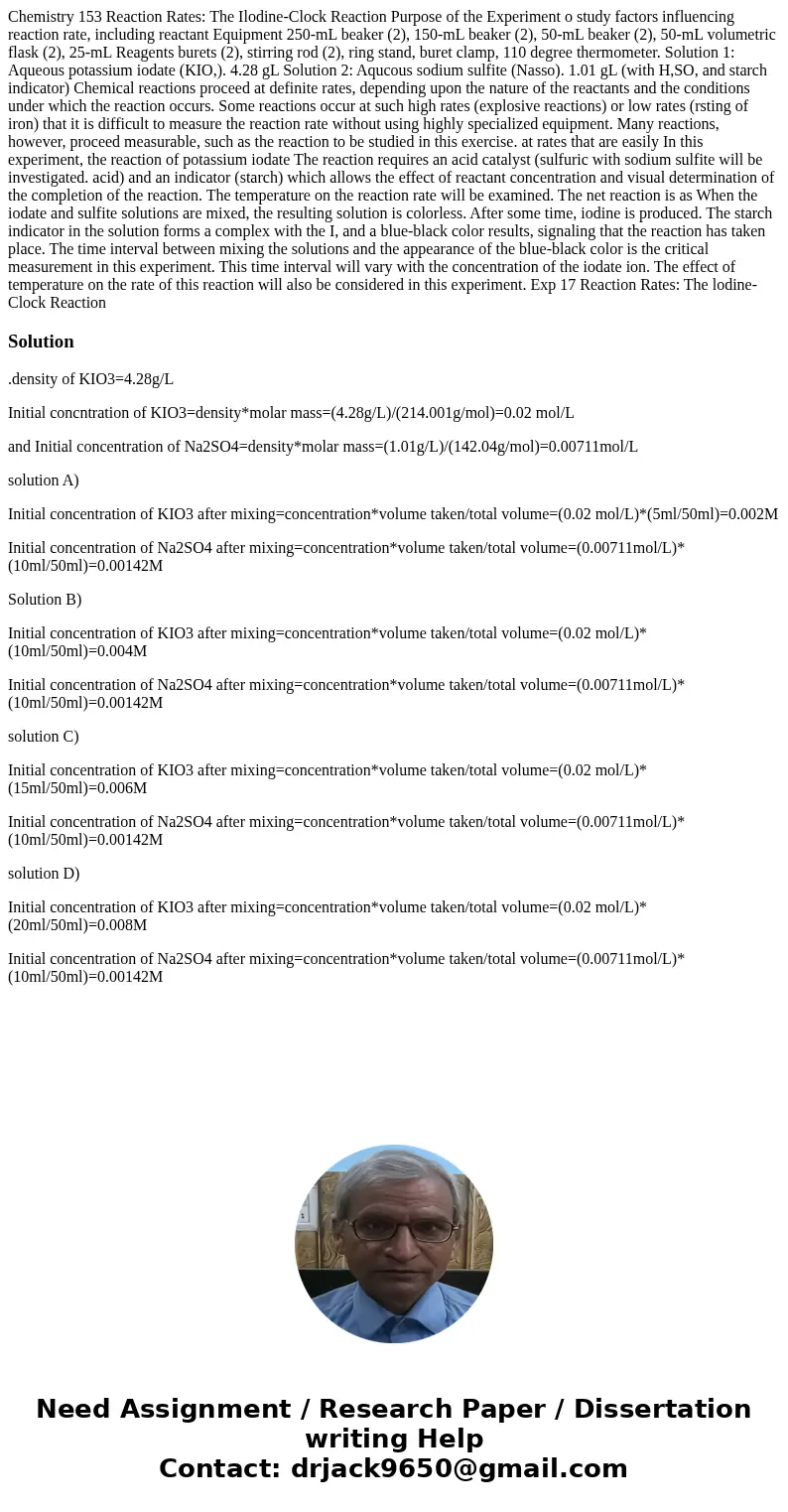Chemistry 153 Reaction Rates: The Ilodine-Clock Reaction Purpose of the Experiment o study factors influencing reaction rate, including reactant Equipment 250-mL beaker (2), 150-mL beaker (2), 50-mL beaker (2), 50-mL volumetric flask (2), 25-mL Reagents burets (2), stirring rod (2), ring stand, buret clamp, 110 degree thermometer. Solution 1: Aqueous potassium iodate (KIO,). 4.28 gL Solution 2: Aqucous sodium sulfite (Nasso). 1.01 gL (with H,SO, and starch indicator) Chemical reactions proceed at definite rates, depending upon the nature of the reactants and the conditions under which the reaction occurs. Some reactions occur at such high rates (explosive reactions) or low rates (rsting of iron) that it is difficult to measure the reaction rate without using highly specialized equipment. Many reactions, however, proceed measurable, such as the reaction to be studied in this exercise. at rates that are easily In this experiment, the reaction of potassium iodate The reaction requires an acid catalyst (sulfuric with sodium sulfite will be investigated. acid) and an indicator (starch) which allows the effect of reactant concentration and visual determination of the completion of the reaction. The temperature on the reaction rate will be examined. The net reaction is as When the iodate and sulfite solutions are mixed, the resulting solution is colorless. After some time, iodine is produced. The starch indicator in the solution forms a complex with the I, and a blue-black color results, signaling that the reaction has taken place. The time interval between mixing the solutions and the appearance of the blue-black color is the critical measurement in this experiment. This time interval will vary with the concentration of the iodate ion. The effect of temperature on the rate of this reaction will also be considered in this experiment. Exp 17 Reaction Rates: The lodine-Clock Reaction
.density of KIO3=4.28g/L
Initial concntration of KIO3=density*molar mass=(4.28g/L)/(214.001g/mol)=0.02 mol/L
and Initial concentration of Na2SO4=density*molar mass=(1.01g/L)/(142.04g/mol)=0.00711mol/L
solution A)
Initial concentration of KIO3 after mixing=concentration*volume taken/total volume=(0.02 mol/L)*(5ml/50ml)=0.002M
Initial concentration of Na2SO4 after mixing=concentration*volume taken/total volume=(0.00711mol/L)*(10ml/50ml)=0.00142M
Solution B)
Initial concentration of KIO3 after mixing=concentration*volume taken/total volume=(0.02 mol/L)*(10ml/50ml)=0.004M
Initial concentration of Na2SO4 after mixing=concentration*volume taken/total volume=(0.00711mol/L)*(10ml/50ml)=0.00142M
solution C)
Initial concentration of KIO3 after mixing=concentration*volume taken/total volume=(0.02 mol/L)*(15ml/50ml)=0.006M
Initial concentration of Na2SO4 after mixing=concentration*volume taken/total volume=(0.00711mol/L)*(10ml/50ml)=0.00142M
solution D)
Initial concentration of KIO3 after mixing=concentration*volume taken/total volume=(0.02 mol/L)*(20ml/50ml)=0.008M
Initial concentration of Na2SO4 after mixing=concentration*volume taken/total volume=(0.00711mol/L)*(10ml/50ml)=0.00142M

 Homework Sourse
Homework Sourse